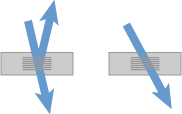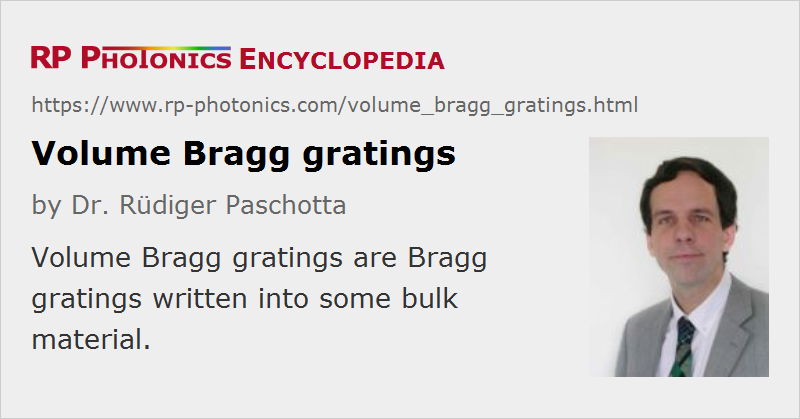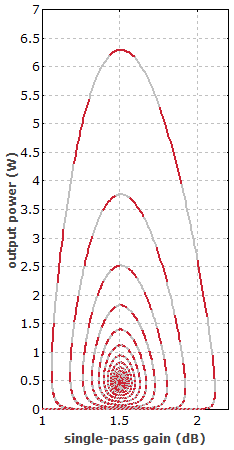Volume Bragg Gratings
Acronym: VBG, VHG
Definition: Bragg gratings written into some bulk material
Alternative term: bulk Bragg gratings
More general term: Bragg gratings
German: Volumen-Bragg-Gitter
How to cite the article; suggest additional literature
Author: Dr. Rüdiger Paschotta
Volume Bragg gratings (also called volume holographic gratings) are Bragg gratings which are written inside some transparent material, e.g. in the form of a cube or a parallelepiped – in contrast to diffraction gratings made on the surface of an optical element or fiber Bragg gratings, where the grating is written into the core of an optical fiber. Typically, such gratings are written into some photosensitive glass, and sometimes into crystal materials. They are also called bulk Bragg gratings or volume holographic gratings.
Some typical properties of volume Bragg gratings:

- Typically, one uses a very small grating period of e.g. below 1 μm, so that one can obtain reflection of light in some narrow optical bandwidth (e.g. 0.1 nm or 0.01 nm) – either directly back into the incoming beam or under some angle. However, there are also transmitting Bragg gratings (TBG), where the diffracted beams on the same side of the device is the transmitted beams.
- The peak reflectance is sometimes only a few percent, in other cases more than 99%. In case of an unchirped grating, it is determined by the length of the grating and the magnitude of the refractive index modulation.
- The shape and width of the reflection spectrum (filter shape) can be tailored to some extent.
- The thickness of such devices (typically several millimeters) is sufficient for allowing substantial beam radii of e.g. a few millimeters. The large beam area in combination with the relatively high optical damage threshold of e.g. multiple J/cm2 then allows for very high peak powers.
- Optical losses related to absorption or scattering of light are usually at a very low level. Therefore, such devices can also be operated at fairly high average power levels.
- Normally, a device contains only a single grating. However, it is possible to have two or more Bragg gratings within the same volume of material.
- There are chirped volume Bragg gratings (CVBG, CBG), i.e., devices where the Bragg wavelength is not constant, but varies continuously along the device. The purpose of the chirp can be e.g. to obtain a large reflection bandwidth or to obtain some amount of chromatic dispersion.
Fabrication of Volume Bragg Gratings
A volume Bragg grating is some transparent medium where there is a periodic modulation of the refractive index in some region (principle of a volume hologram). Such an index modulation can be produced by irradiating over some time interval a photosensitive (photorefractive) glass (e.g. silica containing some dopants) with ultraviolet light in the spatial shape of a standing wave pattern (→ interference). Essentially, two narrow-linewidth ultraviolet light beams are superimposed in the material, having somewhat different propagation directions. The angle between the two beams, together with the optical wavelength and the refractive index of the glass, determines the period of the obtained interference pattern. Some thermal development may follow the irradiation.
In many cases, the end faces of the volume Bragg grating are optically polished and anti-reflection coated in order to avoid parasitic reflections. The grating lines can be parallel or perpendicular to the input and output faces, or have any other orientation.
An alternative method is the direct laser writing technique, using strongly focused ultrashort pulses with high peak intensities.
Applications of Volume Bragg Gratings
Wavelength Stabilization of Lasers
A typical application of volume Bragg gratings is the wavelength stabilization of lasers, most often of laser diodes. For that purpose, a grating is usually placed not directly in front of the laser diode, but after a collimating lens (at least a fast axis collimator). With in some narrow optical bandwidth, it provides additional optical feedback to the laser diode, which forces the diode to emit light only within that bandwidth. In effect, the mean wavelength of the obtained optical spectrum is more or less fixed, whereas without the optical feedback it would substantially depend on the junction temperature of the diode and might increase with continued aging. At the same time, the optical bandwidth of the emission is substantially reduced, e.g. from a few nanometers to a small fraction of 1 nm. This is important, for example, for pumping of certain solid-state lasers, where the laser crystal exhibits efficient pump absorption only in a narrow wavelength range.
Notch Filters
Volume Bragg grating can be used in laser beam as a notch filter: light in some narrow wavelength region is reflected out of the beam, while other light can pass with very low losses.
Spectral Beam Combining
Spectral beam combining is a method for combining several laser beams with slightly different wavelengths into one beam. In the simplest case, two beams are combined, where one is transmitted and the other one is reflected by the grating. Using several superimposed gratings, more beams can be combined. Another possibility is to have all beams reflected on a single grating, each one at a different diffraction angle according to its wavelengths.
Wavelength Division Multiplexing
Volume Bragg gratings can be applied in the context of optical fiber communications with wavelength division multiplexing. Although fiber Bragg gratings would appear to be a more natural choice for system based on fiber optics, these have the disadvantage of allowing only retro-reflection, but not reflection as some angle; one then often requires Faraday circulator for extracting the reflected beam. The disadvantage is avoided by the volume Bragg grating. Such a device can also have multiple gratings within a single glass piece, allowing for quite compact packaging.
For coarse WDM (CWDM), where the past spans are several nanometers white, one typically uses transmitting gratings. For dense WDM (DWDM), narrowband reflections are utilized.
Injecting Pump Light into Laser Resonators
As the reflection occurs only in a short wavelength range, the volume Bragg grating can also be used for injecting pump light into a laser resonator: even if pump and laser wavelength are very close together, the grating may reflect laser light and transmit pump light, or vice versa.
Dispersive Pulse Compression and Stretching
Another common application is dispersive pulse compression. For that purpose, one uses chirped volume Bragg gratings (see above). The operation principle is essentially the same as for chirped mirrors (see the corresponding article), although the parameters are quite different: the refractive index modulation is typically much weaker, but extends over a much longer length. As a result, the obtained range of group delays can be far larger – for device length of the order of 100 mm, as are already possible with sufficiently high precision, ≈ 1 ns stretched pulse duration is possible [10]. The group delay dispersion can also be far larger. Depending on the orientation of the device, the group delay dispersion for reflected light may be positive or negative.
Sometimes, one uses slightly different transverse positions in a single volume Bragg grating for the pulse stretcher and pulse compressor in a chirped-pulse amplification (CPA) system.
Typically, one has only limited control over the variation of grating period and grating strengths over the length of the grating. Therefore, the chromatic dispersion versus wavelength may exhibit substantial oscillations, which can be problematic. In this respect, chirped dielectric mirrors allow a much finer dispersion control because of the precise control of layer thickness values.
The device length of volume Bragg gratings is typically more limited than for fiber Bragg gratings, where it could easily be several tens of centimeters, but the advantage of volume Bragg gratings is that one can use laser beams with very much larger beam radius, so that the device can tolerate far higher peak powers.
Suppliers
The RP Photonics Buyer's Guide contains 5 suppliers for volume Bragg gratings.
Questions and Comments from Users
Here you can submit questions and comments. As far as they get accepted by the author, they will appear above this paragraph together with the author’s answer. The author will decide on acceptance based on certain criteria. Essentially, the issue must be of sufficiently broad interest.
Please do not enter personal data here; we would otherwise delete it soon. (See also our privacy declaration.) If you wish to receive personal feedback or consultancy from the author, please contact him e.g. via e-mail.
By submitting the information, you give your consent to the potential publication of your inputs on our website according to our rules. (If you later retract your consent, we will delete those inputs.) As your inputs are first reviewed by the author, they may be published with some delay.
Bibliography
| [1] | O. M. Efimov et al., “High-efficiency Bragg gratings in photothermorefractive glass”, Appl. Opt. 38 (4), 619 (1999), doi:10.1364/AO.38.000619 |
| [2] | L. B. Glebov, “Volume hologram recording in inorganic glasses”, Glass Science and Technology 75, Suppl. C1, 73 (2002) |
| [3] | K.-H. Liao, “Large-aperture chirped volume Bragg grating based fiber CPA system”, Opt. Express 15 (8), 4876 (2007), doi:10.1364/OE.15.004876 |
| [4] | N. Vorobiev et al., “Single-frequency-mode Q-switched Nd:YAG and Er:glass lasers controlled by volume Bragg gratings”, Opt. Express 16 (12), 9199 (2008), doi:10.1364/OE.16.009199 |
| [5] | J. Lumeau, L. Glebova and L. B. Glebov, “Influence of UV-exposure on the crystallization and optical properties of photo-thermo-refractive glass”, J. Non-Crystalline Solids 354, 425 (2008), doi:10.1016/j.jnoncrysol.2007.06.082 |
| [6] | A. Sevian et al., “Efficient power scaling of laser radiation by spectral beam combining”, Opt. Lett. 33 (4), 384 (2008), doi:10.1364/OL.33.000384 |
| [7] | O. Andrusyak et al., “Spectral combining and coherent coupling of lasers by volume Bragg gratings”, IEEE Sel. Top. Quantum Electron. 15 (2), 344 (2009), doi:10.1109/JSTQE.2009.2012438 |
| [8] | S. Tjörnhammar et al., “Numerical modeling and determination of limiting powers for volume Bragg gratings used in lasers for spectral control”, J. Opt. Soc. Am. B 30 (8), 2326 (2013), doi:10.1364/JOSAB.30.002326 |
| [9] | D. Ott et al., “Scaling the spectral beam combining channels in a multiplexed volume Bragg grating”, Opt. Express 21 (24), 29620 (2013), doi:10.1364/OE.21.029620 |
| [10] | L. Glebov et al., “Volume-chirped Bragg gratings: monolithic components for stretching and compression of ultrashort laser pulses”, Optical Engineering 53 (5), 051514 (2014) |
See also: Bragg gratings, diffraction gratings, fiber Bragg gratings, stabilization of lasers, laser diodes, optical filters, spectral beam combining, pulse compression, pulse stretchers, wavelength division multiplexing
and other articles in the category photonic devices
 |





If you like this page, please share the link with your friends and colleagues, e.g. via social media:
These sharing buttons are implemented in a privacy-friendly way!